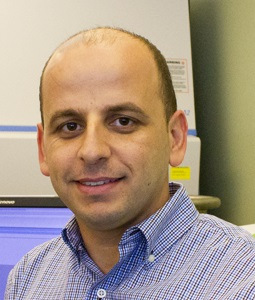Meet the User: Mohammed Baalousha

The National Center for Earth and Environmental Science (NanoEarth) continues the Meet the User Series by highlighting Mohammed Baalousha, Ph.D. Baalousha currently serves as a full professor of Environmental Science at the University of South Carolina (USC) and has partnered with NanoEarth on multiple research projects.
Baalousha has an intrinsic drive for asking questions and completing research, leading to an extensive academic background. He first obtained a Bachelor of Science in Civil Engineering from the Islamic University of Gaza, Palestine; then earned scholarships for both a Master’s of Applied Mechanics and a Doctorate of Philosophy in Environmental Biogeochemistry entitled “Environmental role of colloids as carriers of trace elements” from the University Bordeaux 1 in the Nouvelle-Aquitaine region of southwestern France. His research and academics led him to postdoctoral research roles at the University of Birmingham, United Kingdom, researching environmental nanoscience.
In 2014, the University of South Carolina recruited Baalousha for a tenure track Assistant Professor of Environmental Science position. In the Department of Environmental Health Sciences, within the Arnold School of Public Health, Baalousha not only teaches, he advises high school students, undergraduates, Masters students, Ph.D. students, and supervises postdoctoral fellows. He also leads the Environmental Nanoscience and Analytics Laboratory at USC. His main research focus is on the impact of wildland-urban interface fire emissions on environmental and human health. He looks at the transformation of metals and nanomaterials and how these transformations impact the biogeochemical cycling of metals and nanomaterials.
Baalousha’s research highlights the importance of understanding metal and nanomaterial emission and transformations during wildland-urban (WUI) fire ash on environmental and human health. The importance can be seen in past discoveries such as Chromated arsenicals-treated (CCA) wood related metals and nanomaterials, the reduction of iron oxides to materials such as magnetite, wüstite, and zero valent iron. Studying various metal transformations due to WUI fire ash is paramount to understanding changes in environmental and human health. USC has recently highlighted his research and the associated press discussed the Los Angeles Wildfires.


Baalousha previously researched the fate, behavior, transformations, and environmental impacts of engineered nanomaterials. He developed analytical tools and methodologies for characterization, detection, and monitoring of engineered nanomaterials in the environment. He also researched the role of metal carriers, such as nanoparticles and colloids, in the transport of metals in the aquatic environment. He has more than 120 publications in articles, books, and book chapters. He is a recipient of the NSF CAREER award, NSF-EPSCoR fellowship, and the USC Breakthrough Star award. He has been successfully funded by NSF throughout his career at USC with a recent success in securing a R21 as a co-Investigator. Baalousha is also a member of the American Chemical Society (ACS) and the Association of Environmental Engineering and Science Professionals (AAEES).
Baalousha has partnered with NanoEarth for the TEM analysis of nanoparticles. These include synthetic engineered nanoparticles, nanoparticles released within the urban environment, and nanoparticles in wildland-urban interface fire ash. There are three recently published papers on wildland-urban interface fire ash that include NanoEarth TEM analysis. The papers listed are, “Discovery and potential ramifications of reduced iron-bearing nanoparticles—magnetite, wüstite, and zero-valent iron—in wildland–urban interface fire ashes”; “Wildland-urban interface fire ashes as a major source of incidental nanomaterials”; and “Identification and quantification of Cr, Cu, and As incidental nanomaterials derived from CCA-treated wood in wildland-urban interface fire ashes”.
Baalousha’s main career goal is to continue doing meaningful research that impacts human lives. He enjoys swimming, walking by bodies of water, and spending his free time with his family. His personal goal is to raise his children to be good, well-educated citizens. His advice to young researchers is to feed your curiosity, ask questions, and bring new perspectives to your research. He tells students to not be discouraged if the outcomes of an experiment are different than expected, as that leads them and their mentors to discover something new.






